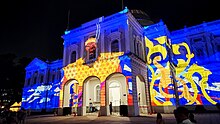
Back Sang Nila Utama German Sang Nila Utama Spanish سانگ نیلا اوتاما Persian Sang Nila Utama Finnish Sang Nila Utama ID Sang Nila Utama Italian Sang Nila Utama Malay Sang Nila Utama Serbo-Croatian Sang Nila Utama SIMPLE நீல உத்தமன் Tamil
| Sang Nila Utama | |
|---|---|
| Sri Tri Buana, "Lord of Three Worlds" | |
 Statue of Sang Nila Utama at the Raffles' Landing Site as part of events commemorating the bicentennial of the founding of modern Singapore, along with other pioneers of the modern period of Singapore.[1] | |
| 1st Raja of Singapura | |
| Reign | 1299–1347 |
| Predecessor | Kingdom established |
| Successor | Sri Wikrama Wira |
| Born | 1278 Palembang |
| Died | 1347 Kingdom of Singapura |
| Burial | Keramat Iskandar Shah, Fort Canning Hill (disputed) |
| Spouse | Wan Sri Bini |
| Issue | Sri Wikrama Wira |
| Father | Sang Sapurba |
| Religion | Hinduism |

Sang Nila Utama was a prince from Palembang and is the founder of the Kingdom of Singapura in 1299.[2][3] His official title adopted upon his coronation was Sri Tri Buana (Sanskrit: श्री त्रि भुवन, romanized: śrī tri bhuvana), which can be translated as "Lord of Three Worlds"; the "Three Worlds" may refer to the three realms of the universe—the heaven of the gods, the world of humans, and the underworld of demons or his lordship over Java, Sumatra and Temasek/Singapura. This title is attested to elsewhere in Southeast Asia.[4]
Sang Nila Utama died in 1347 and his son, Sri Wikrama Wira succeeded him.[5] Malay Annals stated that the name of the founder of Singapore was Sri Tri Buana, who was later associated with the Maharaja of Bhumi Malayu, Srimat Tribhuwanaraja Mauli Warmadewa.[6] The account of his life and those of his successors is given in the Malay Annals; the historicity of the events as recorded there is debated by scholars,[7] and some contend that Sang Nila Utama may be a mythical figure, even if the historicity of Singapore's 14th-century settlement is no longer disputed.[8] Even so, as De Jong argued in his article The Character of Malay Annals, the stories of the Malay Annals could have been realistically mixed with the historical figures and events.[9]
- ^ "Sang Nila Utama, pioneers join Stamford Raffles along Singapore River". Channel NewsAsia. January 2019. Archived from the original on January 4, 2019. Retrieved January 6, 2019.
- ^ Singapore. Ministry of Culture, Singapore. Ministry of Communications and Information. Information Division (1973). "Singapore facts and pictures". Singapore Facts and Figures. Singapore: Ministry of Culture: 9. ISSN 0217-7773.
- ^ Abshire, Jean (2011). The History of Singapore. The Greenwood Histories of the Modern Nations. ABC-CLIO. p. 19. ISBN 978-0-313-37743-3. Retrieved July 18, 2013.
The Malay Annals do not include dates, but tracing the succession of Sang Nila Utama's descendants and dates surrounding events during their reigns suggests the establishment of the new settlement took place in 1299.
- ^ John N. Miksic (November 15, 2013). Singapore and the Silk Road of the Sea, 1300-1800. NUS Press. p. 148. ISBN 978-9971695743.
- ^ Dr John Leyden; Sir Thomas Stamford Raffles (1821). Malay Annals. pp. 47–48.
- ^ Muljana, Slamet (1981). Kuntala, Sriwijaya Dan Suwarnabhumi. Jakarta: Yayasan Idayu.
{{cite book}}: CS1 maint: date and year (link) - ^ John N. Miksic (November 15, 2013). Singapore and the Silk Road of the Sea, 1300-1800. NUS Press. pp. 154–156. ISBN 978-9971695743.
- ^ Cite error: The named reference
turnbullwas invoked but never defined (see the help page). - ^ Hussain, Othman (2005), The Characteristics of the Malay Historiography (PDF), UTHM Institutional Repository